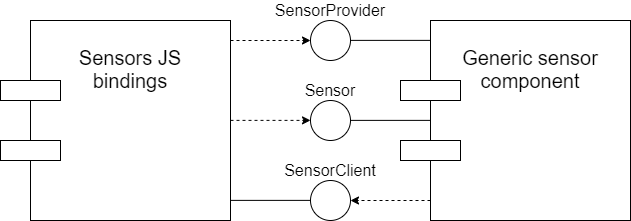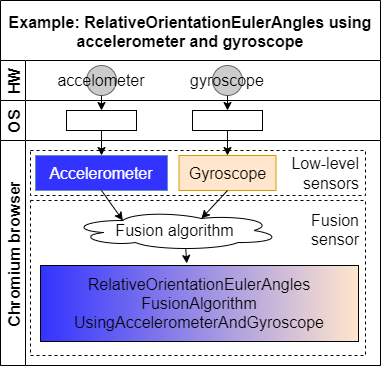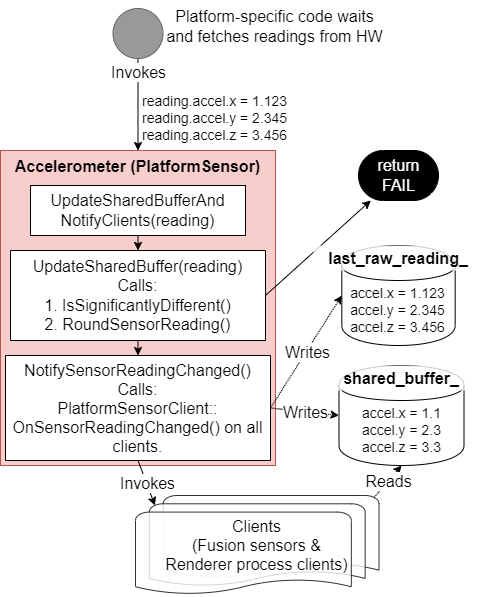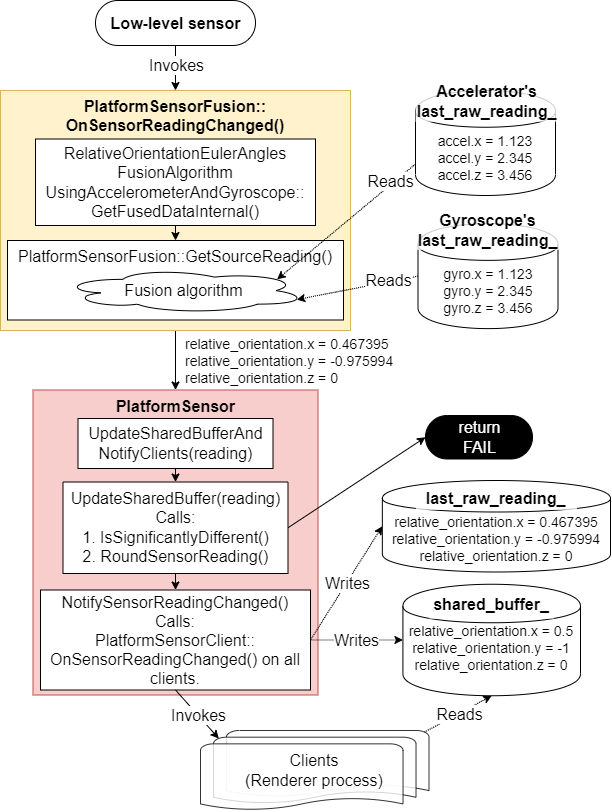README.md
Sensors
[TOC]
Introduction
This document explains how sensor APIs (such as Ambient Light Sensor, Accelerometer, Gyroscope, Magnetometer) are implemented in Chromium.
This directory contains the platform-specific parts of the implementation, which is used, among others, by the Generic Sensor API and the Device Orientation API.
The document describes the Generic Sensor API implementation in both the renderer and the browser process and lists important implementation details, such as how data from a single platform sensor is distributed among multiple JavaScript sensor instances and how sensor configurations are managed.
Background
The Generic Sensor API defines base interfaces that should be implemented by concrete sensors. In most cases, concrete sensors should only define sensor-specific data structures and, if required, sensor configuration options.
The same approach is applied to the implementation in Chromium, which was designed with the following requirements in mind:
- Share the crucial parts of functionality between the concrete sensor implementations. Avoid the code duplication and thus simplify maintenance and development of new features.
- Support simultaneous existence and functioning of multiple JS Sensor instances of the same type that can have different configurations and lifetimes.
- Support for both “slow” sensors that provide periodic updates (e.g. Ambient Light, Proximity), and “fast” streaming sensors that have low-latency requirements for sensor reading updates (motion sensors).
Note: the implementation is architected in such a way that Blink (i.e.
third_party/blink/renderer/modules/sensor) is just a consumer of the data from
services/device/generic_sensor like any other. For example, the Blink Device
Orientation API
consumes sensor data from //services independently from the Blink Generic
Sensor implementation. The same applies to
device/vr/orientation.
Implementation Design
Main components and APIs
The Generic Sensor API implementation consists of two main components: the
sensor module in Blink
(//third_party/blink/renderer/modules/sensor/)
which contains JS bindings for Generic Sensor API and concrete sensors APIs, and
the generic_sensor device service
(//services/device/generic_sensor/) - a set
of classes running on the service process side that eventually call system APIs
to access the actual device sensor data.
The //services side also includes a few other directories:
//services/device/public/cpp/generic_sensorcontains C++ classes and data structures used by both//services/device/generic_sensoras well as its consumers.//services/device/public/mojomcontains Mojo interfaces by the Generic Sensor implementation.- SensorProvider is a “factory-like” interface that provides data about the sensors present on the device and their capabilities (reporting mode, maximum sampling frequency), and allows users to request a specific sensor.
- Sensor is an interface wrapping a concrete device sensor.
- SensorClient is implemented by Blink (and other consumers) to be notified about errors occurred on platform side and about sensor reading updates for sensors with ‘onchange’ reporting mode.
Actual sensor data is not passed to consumers (such as Blink) via Mojo calls - a shared memory buffer is used instead, thus we avoid filling up the Mojo IPC channel with sensor data (for sensors with continuous reporting mode) when the platform sensor has a high sampling frequency, and also avoid adding extra latency.
A high-level diagram of the Mojo architecture looks like this:
Sensor Fusion
Some sensors provide data that is obtained by combining readings from other sensors (so-called low-level sensors). This process is called sensor fusion. It can be done in hardware or software.
In Chromium, we sometimes perform software sensor fusion when a certain hardware sensor is not available but «fusing» readings from other sensors provides a similar reading. The fusion process involves reading data from one or more sensors and applying a fusion algorithm to derive another reading from them (possibly in a different unit).
The figure below figure shows an overview of the fusion sensor flow:
In the code, the main classes are
PlatformSensorFusion and
PlatformSensorFusionAlgorithm.
PlatformSensorFusion owns a PlatformSensorFusionAlgorithm instance. It
inherits from both PlatformSensor as well as PlatformSensor::Client. The
former indicates it can be treated by consumers as a regular sensor, while the
latter means that it subscribes to updates from low-level sensors (like
SensorImpl itself). It is in its implementation of
OnSensorReadingChanged() that it invokes its PlatformSensorFusionAlgorithm
to fuse data from the underlying sensors.
Once any of the low-level sensors receive a new value, it notifies its clients
(including the fusion sensor). The fusion sensor algorithm reads the low-level
sensor raw values and outputs a new reading, which is fed to
PlatformSensor::UpdateSharedBufferAndNotifyClients() as usual.
Security and Privacy
Platform sensor readings can expose more information about a device and consequently lead to an increase in the fingerprinting surface exposed by the browser, eavesdropping, and keystroke monitoring.
The security and anti-fingerprinting considerations are also based on existing literature on the topic, especially research on sensors exposed to native applications on mobile devices:
- Gyrophone: Recognizing Speech from Gyroscope Signals
- ACCessory: password inference using accelerometers on smartphones
- Touchsignatures: identification of user touch actions and pins based on mobile sensor data via javascript
- SoK: Systematic Classification of Side-Channel Attacks on Mobile Devices
- Pin skimming: Exploiting the ambient-light sensor in mobile devices
- TapLogger: Inferring User Inputs On Smartphone Touchscreens Using On-board Motion Sensors
The Generic Sensor implementation in Chromium follows the Mitigation Strategies section of the Generic Sensor API specification. Namely, this means that:
- The sensor APIs are only exposed to secure contexts (the same also applies to the API exposed by the Device Orientation spec).
- There is integration with both the Permissions API and the Permissions Policy API.
- Sensor readings are only available to documents whose visibility state is «visible» (this also applies to the Device Orientation API).
- Sensor readings are only available for active documents whose origin is same origin-domain with the currently focused area document.
The Chromium implementation also applies additional privacy measures (some of which are making their way back to the specification):
- Frequency: The maximum sampling frequency is capped at 60Hz for most sensor types. Ambient Light sensors and magnetometers are capped at 10Hz.
- Accuracy: Readings are quantized, and for some sensor types readings which do not differ by a certain threshold are discarded and never exposed.
There is no distinction in how the Generic Sensor APIs are exposed to regular and incognito windows.
Classes & APIs
//services main classes
PlatformSensorProvider: singleton class whose main functionality is to create and trackPlatformSensorinstances.PlatformSensorProvideris also responsible for creating a shared buffer for sensor readings. Every platform has its own implementation ofPlatformSensorProvider(PlatformSensorProviderAndroid,PlatformSensorProviderWinetc), and the generic part of the functionality is encapsulated inside thePlatformSensorProviderBaseclass.PlatformSensor: represents device sensor of a given type. There can be only onePlatformSensorinstance of the same type at a time, its ownership is shared between existingSensorImplinstances.PlatformSensoris an abstract class which encapsulates generic functionality and is inherited by the platform-specific implementations (PlatformSensorAndroid,PlatformSensorWinetc).SensorImpl: implements the exposedSensorMojo interface and forwards IPC calls to the owned PlatformSensor instance.SensorImplimplements thePlatformSensor::Clientinterface to receive notifications fromPlatformSensor.SensorProviderImpl: implements the exposedSensorProviderMojo interface and forwards IPC calls to thePlatformSensorProvidersingleton instance.
The classes above have the following ownership relationships:
SensorProviderImplowns a singlePlatformSensorProviderinstance via astd::unique_ptr.SensorProviderImplowns allSensorImplinstances via amojo::UniqueReceiverSet.PlatformSensoris a ref-counted class, and aSensorImplhas a reference to aPlatformSensor.DeviceServiceowns a singleSensorProviderImplinstance.DeviceService::BindSensorProvider()is responsible for creating aPlatformSensorProviderif one does not exist and pass it toSensorProviderImpl.
Blink main classes
Sensor: implements bindings for theSensorIDL interface. All classes that implement concrete sensor interfaces (such asAmbientLightSensor,Gyroscope,Accelerometer) must inherit from it.SensorProviderProxy: owns one side of theSensorProviderMojo interface pipe and managesSensorProxyinstances. This class supplementsDOMWindow, soSensorobtains aSensorProviderProxyinstance viaSensorProviderProxy::From()and uses it to the getSensorProxyinstance for a given sensor type.SensorProxy: owns one side of theSensorMojo interface and implements thedevice::mojom::blink::SensorClientMojo interface. It also defines aSensorProxy::Observerinterface that is used to notifySensorand its subclasses of errors or data updates from the platform side.Sensorand its subclasses interact with the//servicesside viaSensorProxy(andSensorProviderProxy) rather than owning the Mojo pipes themselves.
In a LocalDOMWindow, there is one SensorProxy instance for a given sensor
type (ambient light, accelerometer, etc) whose ownership is shared among
Sensor instances. SensorProxy instances are created when Sensor::start()
is called and are destroyed when there are no more active Sensor instances left.
Code flow
Low-level sensor
The figure below shows the code flow for a low-level (i.e. non-fusion) sensor:
Each OS-specific PlatformSensor implementation retrieves sensor readings
differently, but they all ultimately call
PlatformSensor::UpdateSharedBufferAndNotifyClients(). This function invokes
PlatformSensor::UpdateSharedBuffer() in
platform_sensor.cc, which checks and transforms a
reading before storing it in the shared buffer:
- Sensors whose reporting mode is
mojom::ReportingMode::ON_CHANGE(i.e. they only send notifications when the reading has changed) first check if the new value is different enough compared to the current value. What is considered different enough (i.e. the threshold check) varies per sensor type (seePlatformSensor::IsSignificantlyDifferent()for the base implementation). Threshold-chapter has more information why code uses threshold value. And Used threshold values-chapter has the actual values. - If the check above passes, the so-called «raw» (unrounded) reading is stored
to
last_raw_reading_. - The reading is rounded via
RoundSensorReading()(inplatform_sensor_util.cc) using a per-type algorithm. Rounding-chapter has more information why sensor values are rounded. - The rounded reading is stored in the shared buffer and becomes the value that clients can read.
Fusion sensor
Fusion sensors behave similarly, but with extra steps at the end:
- They get notified of a new reading when
PlatformSensor::UpdateSharedBufferAndNotifyClients()invokesPlatformSensorFusion::OnSensorReadingChanged(). PlatformSensorFusion::OnSensorReadingChanged()invokes the sensor’s fusion algorithm, which fetches the low-level sensors’ raw readings and fuses them.- It invokes
UpdateSharedBufferAndNotifyClients(), which will go through the same threshold check and rounding process described above, but for the fused reading.
The figure below shows an example of the code flow:
Rounding and threshold checks
Rounding
Rounding is a form of quantization. It is used to reduce the accuracy of raw sensor readings in order to help reduce the fingerprinting surface exposed by sensors. For example, instead of exposing an accelerometer reading of 12.34567m/s^2, we expose a value of 12.3m/s^2 instead. https://crbug.com/1018180 and https://crbug.com/1031190 show examples of issues we try to avoid by providing rounded readings.
Choosing how much rounding to apply is a balance between reducing the
fingerprinting surface while also still providing values that are meaningful
enough to users. platform_sensor_util.h contains the
values we use for each different sensor type.
Currently magnetometer, pressure and proximity sensor readings are not rounded (magnetometer is not exposed by default, and there is no backend implementation for pressure and proximity sensors).
Threshold checks
To prevent small changes around the rounding border from triggering notifications, a threshold check is performed and readings that fail it are discarded. Rounding is the main measure to prevent fingerprinting and data leaks, and the threshold checks play an auxiliary role in conjunction with it by reducing the number of updates when a raw reading is hovering around a certain value.
Note: see the discussions in https://crrev.com/c/3666917 and https://crbug.com/1332536 about the role threshold checks play as a mitigation strategy. On the one hand, there is no mathematical analysis behind its use as a security measure, on the other hand we know that it does reduce the number of updates and does not increase the attack surface.
Note: threshold checks are only performed for sensors whose reporting mode
is ON_CHANGE. We consider that for sensors with a CONTINUOUS reporting mode
it is more important to report readings at a certain rate than to ignore similar
readings.
For example, if the code rounded readings to the nearest multiple of 50 and no threshold checks were done, a change from a raw value of 24 (rounded to 0) to 25 (rounded to 50) would trigger a new reading notification, whereas requiring the raw readings to differ by 25 guarantees that the readings must differ more significantly to trigger a new notification.
The actual checks differ by sensor type:
- Ambient Light Sensor readings must differ by half of the rounding multiple
(
kAlsRoundingMultiple), or 25 lux in practice. - Fusion sensors default to requiring a difference of 0.1 in readings, which
can be changed by calling
PlatformSensorFusionAlgorithm::set_threshold() - Other low-level sensors only check for equality between current and new readings at the moment.
Execution order of rounding and threshold check
We first perform a threshold check on the current and new raw readings and only perform rounding and store the new rounded reading if the threshold check passes.
If we did rounding first, we would increase even more the area which rounding already protects, and callers would get values that are too inaccurate.
Permissions
Permissions API integration
The Sensor.start() operation
in the Generic Sensor spec invokes the request sensor
access abstract
operation so that permission checks (via the Permissions
API are performed before a sensor is
started.
In Chromium, the permission checks are done in the //content/browser side:
SensorProviderProxyImpl::GetSensor() invokes
PermissionController::RequestPermissionFromCurrentDocument() and only
connects to the //services side if permission has been granted.
Note: At the moment, users are never prompted to grant access to a device’s
sensors, access is either allowed or denied. This ended up happening for
historical reasons: the Device Orientation API was implemented first and neither
spec nor implementation were supposed to prompt for sensor access (it was
retrofitted into the spec years later), the Generic Sensor API was added to
Chromium later, the Device Orientation API in Blink was changed to use the same
backend in //services, and the permission behavior was kept to avoid breaking
user compatibility. Work to improve the situation for both the Device
Orientation API and the Generic Sensor API in Chromium is tracked in
https://crbug.com/947112.
From a UI perspective, users are able to grant or deny access to sensors in the global settings (chrome://settings/content) or on a per-site basis even before work on issue 947112 is finished.
Permissions policy integration
The Chromium implementation follows the spec and integrates with the Permissions Policy spec.
The Policy Controlled Features page lists the current status of different features.
Blink performs checks in
Sensor::Sensor() by
calling AreFeaturesEnabled(), while the content/ side also performs checks
in
SensorProviderProxyImpl::CheckFeaturePolicies().
Reporting values to consumer
Reporting modes
Sensors have two ways of reporting new values as defined in
ReportingMode. The values are
based on the Android sensor reporting
modes:
ON_CHANGE: Clients are notified viaPlatformSensor::Client::OnSensorReadingChanged()when the measured values have changed. Different sensor types have different thresholds for considering whether a change is significant enough to be reported as discussed in the round and thresholds section.CONTINUOUS: Sensor readings are continuously updated at a frequency derived fromPlatformSensorConfiguration.frequency. The sampling frequency value is capped to 10Hz or 60Hz (defined insensor_traits.h) for security reasons as explained in the Security and Privacy section of this document.PlatformSensor::Client::OnSensorReadingChanged()is never invoked, and clients are expected to periodically fetch readings on their own viaSensorReadingSharedBufferReader::GetReading().
There is no default reporting mode: PlatformSensor subclasses are expected to
implement the GetReportingMode() method and return a value fit for the given
OS and sensor type.
Configuration and frequency management
As described above, there is always at most one PlatformSensor instance for a
given sensor type, and it can have multiple clients consuming its readings. Each
client might be interested in receiving readings at a different frequency, and
it is up to PlatformSensor to coordinate these requests and choose a reading
frequency.
Clients first invoke the SensorProvider.GetSensor() Mojo
method; on success, the
return values include a Sensor Mojo
interface. Clients then invoke the
Sensor.AddConfiguration() and Sensor.RemoveConfiguration() to add and remove
SensorConfiguration instances from the given Sensor.
When a new configuration is added, PlatformSensor::UpdateSensorInternal() is
called and will ultimately choose the highest of all requested frequencies
(within the boundaries defined in
sensor_traits.h
for security reasons). In other words, a client’s requested frequency does not
necessarily match PlatformSensor’s actual sampling frequency (or the frequency
the OS ends up using).
It is then up to each client to check a reading’s timestamp and decide whether to ignore it if not enough time has passed since the previous reading was delivered. It is also possible for clients to simply process all readings regardless of the actual sampling frequency.
Blink adopts the former strategy:
- For sensors with a
CONTINUOUSreporting mode,SensorProxyImplpolls the shared memory buffer at the highest requested frequency. For sensors with aON_CHANGEreporting mode, it will receive updates from the services side viaSensorProxyImpl::SensorReadingChanged(). - Each individual
Sensorinstance connected to aSensorProxyImplwill be notified viaSensor::OnSensorReadingChanged(), which takes care of avoiding sending too many «reading» JS notifications depending on the Sensor instance’s requested frequency.
Sensor readings shared buffer
As mentioned above, sensor readings are not transmitted from the services side to the consumers (such as the renderer process) via IPC calls, but with a shared memory buffer. Read-write operations are synchronized via a seqlock mechanism.
The PlatformSensorProvider singleton owned by DeviceService maintains a
shared memory mapping of the entire buffer. Only PlatformSensorProvider has
write access to it; all consumers only have read-access to the buffer. This
shared buffer is a contiguous sequence of SensorReadingSharedBuffers, one per
mojom::SensorType.
Each SensorReadingBuffer structure has 6 tightly-packed 64-bit floating
fields: seqlock, timestamp, sensor reading 1, sensor reading 2,
sensor reading 3, and sensor reading 4. This has a fixed size of 6 * 8 =
48 bytes. The whole shared buffer’s size depends on mojom::SensorType’s size;
at the time of writing, there are 12 distinct sensor types, which means the
entire shared buffer handle is 12 * 48 = 576 bytes in size.
sensor_reading.h
has the actual SensorReading data structure as well as the
SensorReadingSharedBuffer structure.
The code treats each SensorReadingBuffer embedded in the mapping as completely
independent from the others: SensorReadingSharedBuffer::GetOffset() provides
the offset in the buffer corresponding to the SensorReadingBuffer representing
a given sensor type, SensorReadingSharedBufferReader::Create() requires an
offset to map only a specific portion of the shared buffer and, additionally,
each SensorReadingBuffer has its own seqlock for coordinating reads and
writes.
In terms of code flow, the creation and sharing of the shared buffer when
between Blink calls SensorProviderProxy::GetSensor() works roughly like this:
SensorProviderProxy::GetSensor()calls theGetSensor()operation in the Sensor Mojo interface.- That is implemented by
SensorProviderImpl::GetSensor(). It invokesPlatformSensorProviderBase::CloneSharedMemoryRegion().PlatformSensorProviderBase::CloneSharedMemoryRegion()initializes the shared buffer and the mapping if necessary inPlatformSensorProviderBase::CreateSharedBufferIfNeeded().PlatformSensorProviderBase::CloneSharedMemoryRegion()returns a read-only mapping handle.
- If the platform sensor still needs to be created,
SensorProviderImpl::GetSensor()will invokePlatformSensorProviderBase::CreateSensor(), which invokesPlatformSensorProviderBase::GetSensorReadingSharedBufferForType(). TheSensorReadingSharedBufferpointer returned by this function is later passed toPlatformSensorand its subclasses, which update it when the readings change. - Ultimately,
PlatformSensorProviderBase::SensorCreated()is called, and the read-only shared buffer handle and the offset in it corresponding to the sensor type being created are passed inmojom::SensorInitParams. - On the Blink side,
SensorProxyImpl::OnSensorCreated()is invoked with theSensorInitParamsinitialized above. It invokesSensorReadingSharedBufferReader::Create()with the buffer and offset fromSensorInitParams, and that is what it later used to obtain readings.
Platform-specific details
Android
The Android implementation in //services consists of two parts, native (C++)
and Java. The native side includes PlatformSensorProviderAndroid and
PlatformSensorAndroid, while the Java side consists of the
PlatformSensorProvider and PlatformSensor classes that are included in the
org.chromium.device.sensors package. Java classes interface with Android
Sensor API to fetch readings from device sensors. The native and Java sides
communicate via JNI.
The PlatformSensorProviderAndroid C++
class inherits from PlatformSensorProvider and is responsible for creating a
PlatformSensorProvider (Java) instance via JNI. When the Java object is
created, all sensor creation requests are forwarded to the Java object.
The PlatformSensorAndroid C++ class inherits from
PlatformSensor, owns the PlatformSensor Java object and forwards start, stop
and other requests to it.
The
PlatformSensorProvider
Java class is responsible for thread management, and PlatformSensor creation.
It also owns the Android SensorManager object that is accessed by
PlatformSensor Java objects.
The
PlatformSensor
Java class implements the SensorEventListener interface and owns the Android
Sensor object. PlatformSensor adds itself as an event listener to receive
sensor reading updates and forwards them to native side using the native*
methods.
Windows
The Windows backend has its own README.md.
ChromeOS
On ChromeOS, sensors are implemented with Mojo connections to IIO Service, a CrOS daemon that provides sensors’ data to other applications.
Need to add information about iio service and the platform-specific implementation that reads sensor data and feeds it to Chromium
Linux
Sensor data is exposed by the Linux kernel via its Industrial I/O (iio) subsystem. Sensor readings and metadata are readable via sysfs; udev is used for device enumeration and getting notifications about sensors that are added or removed from the system.
PlatformSensorProviderLinuxBase is
shared between the Linux and ChromeOS implementations, and
PlatformSensorProviderLinux is its
Linux-specific subclass. Similarly,
PlatformSensorLinux inherits from the base
PlatformSensor class.
The implementation is supported by a few more classes:
SensorDeviceManager: interfaces with udev by subclassingdevice::UdevWatcher::Observer. It enumerates all sensors exposed by the Linux kernel via udev, caches their information (frequency, scaling value, sysfs location etc) and notifies users (i.e.PlatformSensorProviderLinux) of changes later.SensorInfoLinux: gathers all iio sensor information in a single struct (frequency, scaling value, sysfs location etc).SensorReaderandPollingSensorReaderimplement the reading and reporting of sensor data from sysfs.
When a request for a specific type of sensor comes and
PlatformSensorProviderLinux::CreateSensorInternal() is called, it will either
cause SensorDeviceManager to start enumerating all available sensors if that
has not happened yet or look for a specific sensor in SensorDeviceManager’s
cache. That is then used to construct a new PlatformSensorLinux object (which
takes a SensorInfoLinux pointer), which then owns a SensorReader that uses
the SensorInfoLinux to know which sensor data to read and how to parse it.
macOS
PlatformSensorProviderMac implements PlatformSensorProvider and is
responsible for creating one of the two classes implementing sensor support on
Mac:
PlatformSensorAccelerometerMacexposes accelerometer data and can be in sensor fusion (e.g.RelativeOrientationEulerAnglesFusionAlgorithmUsingAccelerometer). It is backed by theSuddenMotionSensorcode in third_party and thus relies on being able to read from the SMCMotionSensor.PlatformSensorAmbientLightMacexposed ambient light data from laptop models that support and expose it.
As evidenced above, macOS provides limited support for reading sensor data, and
it is mostly restricted to older laptop models. In the future, it might be
possible to remove all the Mac code from //services/device/generic_sensor.




